(完整版)二语习得文献综述
二语习得文献综述
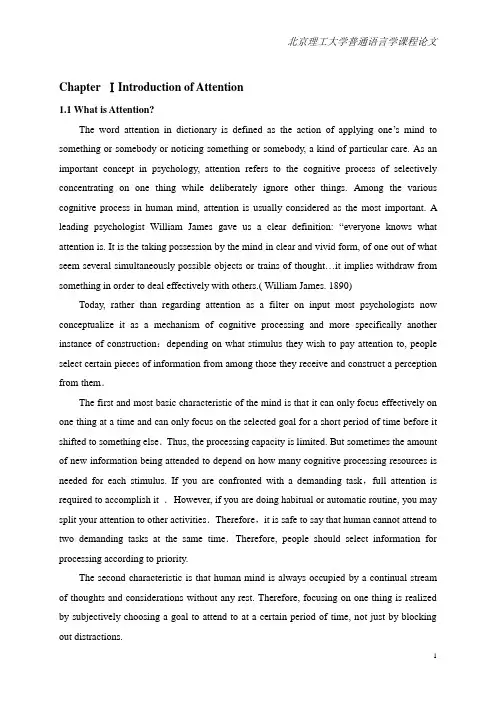
Chapter ⅠIntroduction of Attention1.1 What is Attention?The word attention in dictionary is defined as the action of applying one’s mind to something or somebody or noticing something or somebody, a kind of particular care. As an important concept in psychology, attention refers to the cognitive process of selectively concentrating on one thing while deliberately ignore other things. Among the various cognitive process in human mind, attention is usually considered as the most important. A leading psychologist William James gave us a clear definition: “everyone knows what attention is. It is the taking possession by the mind in clear and vivid form, of one out of what seem several simultaneously possible objects or trains of thought…it implies withdraw from something in order to deal effectively with others.( William James. 1890)Today, rather than regarding attention as a filter on input most psychologists now conceptualize it as a mechanism of cognitive processing and more specifically another instance of construction:depending on what stimulus they wish to pay attention to, people select certain pieces of information from among those they receive and construct a perception from them.The first and most basic characteristic of the mind is that it can only focus effectively on one thing at a time and can only focus on the selected goal for a short period of time before it shifted to something else.Thus, the processing capacity is limited. But sometimes the amount of new information being attended to depend on how many cognitive processing resources is needed for each stimulus. If you are confronted with a demanding task,full attention is required to accomplish it .However, if you are doing habitual or automatic routine, you may split your attention to other activities.Therefore,it is safe to say that human cannot attend to two demanding tasks at the same time.Therefore, people should select information for processing according to priority.The second characteristic is that human mind is always occupied by a continual stream of thoughts and considerations without any rest. Therefore, focusing on one thing is realized by subjectively choosing a goal to attend to at a certain period of time, not just by blocking out distractions.1.2 Vocabulary Knowledge and Vocabulary Acquisition ProcessNo doubt, foreign language vocabulary is viewed as a footstone factor in successful communication (Ellis 1994)and,to a great extent,in high-level reading ability and comprehension. A large number of the studies in SLA examine the role of context in vocabulary acquisition which takes place through reading or reading-associated tasks.Context plays a primordial role in this acquisition by supplying the necessary input and trigger.A plausible explanation of lexical acquisition is a theory about the active role of the learner in the process of vocabulary acquisition.Learners should be encouraged to make their own lexical associations when they are actively learning new vocabulary.The importance of vocabulary knowledge in L2 learning is supported by the schema-based approach to language learning.The learning theory based on information processing and the role of cognitive processes suggests that the information from long-term memory can be used to enrich the learners’understanding or retention of the new ideas by providing related information or schemata into which the new ideas call be organized.An often quoted definition of learning is the process by which information is obtained,stored,retrieved and used.Learning in itself cannot be separated from what is being learned or from the process of learning.For the learning of L2 vocabulary, Brown(1993)has identified five steps:(a)having sources for encountering new words;(b)getting a clear image,either visual or auditory or both, of the forms of the new words;(c)learning the meaning of the words;(d)making a strong memory connection between the forms and the meanings of the words;(c)using the words.Accordingly, learning L2 vocabulary is,to some extent,related to these five steps,which,in a more or less degree,is associated with the attention mechanism in the cognitive process of L2 lexical acquisition. Lexical knowledge lies at the core of L2 vocabulary acquisition but as Laufer observe,“no clear and unequivocal consensus exists as to the nature of lexical knowledge”.According to Nation (2004) vocabulary learning process consists of three psychological conditions:noticing,retrieval and creative use.Noticing,the first process is induced by, forexample,the salience of the word,learners’attention to the word,learner’s interest and motivation,etc.Noticing involves decontextualization and negotiation.The second process,retrieval is the proper way to strengthen the memory and the creative or generative use makes evident the extent to which the language user demonstrates his ability to use knowledge of linguistic rules for communication.Chapter ⅡAttention in Noticing HypothesisSchmidt raises his claim that noticing is the necessary and sufficient condition for the conversion of input into intake for learning (1994). Awareness of the form is a prerequisite for the learning of a form. In the light of Schmidt, noticing is in need of learner’s focal attention and awareness, and subliminal learning cannot explain SLA process. The noticing hypothesis further states that it is whatever features of the input relevant for the target system not just the input in a global sense that must be noticed. From the above theory, we can see that only by attention to specific aspects of the input can learners acquire these aspects of the input.According to Schmidt, by noticing is meant the subjective experience of the stimuli. It seems that noticing critically contains awareness, and Schmidt appears to include awareness with attention as central to noticing, Schmidt also expounds the role and the nature of noticing. In a restrict sense, noticing is isomorphic with Tomlin and Villa’s (1994) detection of selective attention, and to Robinson’s detection plus rehearsal in short term memory. Schmidt assumed that the objects of attention and noticing are elements of the surface structure of input language, rather than any abstract rules or principles of which such instances may be examples. Schmidt made relative claim that unattended stimuli remain in immediate short term memory for a very short time, and attention is the necessary and sufficient condition for stimuli to enter long term memory. In SLA, it is usually considered that attention selects the essential materials in input to be accessible for further central mental processing.Although consensus has arrived on the importance of attention, disagreement exists in the amount and types of attention. In Tomlin and Villa’s view (1994), attention contains three interrelated networks, namely, alertness, orientation, and detection, with alertness and orientation serving to make detection more likely, however, not ensuring detection or learning, and detection being the process by which particular examples are registered in memory and therefore can be made accessible to whatever the key processes are for learning (Tomlin & Villa, 1994).According to them, detection requires no awareness. Up to this point, further mention should be made of awareness under the framework of both SLA and cognitive science. Awareness refers to a particular state of mind in which an individual has undergone a specific subjective experience of some cognitive content or external stimulus.For the two opposing views of attention by Schmidt and Tomlin & Villa, Robinson has attempt to compromise their views. Noticing is defined as what is detected and then further activated following the allocation of attention resources from a central executive. (Robinson, 1995). Robinson argues that different tasks may result in different cognitive processing, and that different task demands may have an effect on attentional allocation, which consequently works on the quality of second language comprehension and production. Robinson argues that both Tomlin & Villa’s detection and Schmidt’s noticing require attention, and learning won’t occur without attention. Robinson persists that awareness is crucial to noticing, agreeing with Schmidt claim that there is no learning without awareness at the level of noticing.Schmidt and Robinson have conviction that awareness is necessary for learning. In terms of his strong version of noticing hypothesis, while there is evidence for subliminal perception, subliminal learning is impossible. Unattended stimuli enter short term memory. If they are not noticed and selected via attention, they are not likely to enter long term memory. Therefore, as claimed by Schmidt (1990), only conscious noticing causes intake, which is meant to be pertinent to the learning of all respects of language. Schmidt still argued that the amount of noticing is in proper proportion to that of learning in that whoever notices most means whoever pays attention most. What’s more, Schmidt claims that many factors such as task demands, frequency, ect. Noticing is not end of the learning process but the initial step in language building.Schmidt (1990) identifies three aspects of consciousness involved in language learning: awareness, intention and knowledge. The first sense, consciousness as awareness, embraces noticing. According to Schmidt (1995), "the noticing hypothesis states that what learners notice in input is what becomes intake for learning." Schmidt also states that a) whether a learner deliberately attends to a linguistic form in the input or it is noticed purely unintentionally, if it is noticed it becomes intake; and b) that noticing is a necessary condition for SLA. To help clarify Schmidt's hypothesis and the place of noticing in SLA the following model, proposed by Ellis, is useful.Ellis has based his model on current theories of SLA, where two main stages are seen to be involved in the process of input becoming implicit knowledge. The first stage, in which input becomes intake, involves learners noticing language features in the input, absorbing them intotheir short-term memories and comparing them to features produced as output. With regard to short-term memory, Kihlstrom (1984) suggests that 1) consciousness and short-term memory are essentially the same; 2) that for language items to be stored in long-term memory they must be processed in short-term memory; and 3) that items not processed into short-term memory or not further encoded into long-term memory from short-term memory will be lost. Schmidt therefore concludes, "If consciousness is indeed equivalent to the short term store, these amounts to a claim that storage without conscious awareness is impossible".The second stage is one in which intake is absorbed into the learner's interlanguage system and changes to this system only occur when language features become part of long-term memory.Chapter ⅢAttention and Second Language Vocabulary Acquisition ProcessV ocabulary entails less complicated and abstract grammatical rules compared with syntax. Therefore, it seems there is no need for too great amount of focal attention and external efforts, for learners can assimilate the new words by directly memorizing them. However, many other facts refute the above statement. More often than not, students complain the difficulty of memorizing a large number of words in a due period of time, and sometimes, even the learned words can not keep in the memory for an expecting long time ready for retrieval. A more demanding problem is that even if the learners know the meanings of the words, they can not put them into proper use. All of the above problems show that vocabulary acquisition is not just an easy case of memory. It requires much more external controlled attention to every aspects of a new word, ranging from pronunciation, spelling to collocation and usage in a real context. A large number of theoretical and empirical studies have been done to verify the effects of different methods and strategies to facilitate vocabulary learning. Laufer conclude that elaboration, the same concept as “processing depth”,is the most important factor affecting vocabulary acquisition. Their further argument is from William James’s (1890) notion that all improvement of the memory lies in the line of elaborating the associates. In other words, the more special attention learners pay to the form and semantic associates the deeper the words be processed and the more meaningful associates will be the previously existing knowledge in learners’ interlanguge system.ConclusionWe can say attention plays a very important role in vocabulary acquisition, for it is the prerequisite from input to intake and output. Besides, we can find that attention appears in the first place in the area of processing depth, for great elaboration for new words can help promote vocabulary acquisition from the perspective of quantity and quality of input, and then for deeper processing in working memory which in turn enhances good memory for convenient retrieval. Without focal attention to certain items, all of the input will just stay in working memory for a short period of time and then fall into oblivion.References:[1] Brown ,C. Factors affecting the acquisition of vocabulary: frequency and saliency of words[A]. 1993[2] Ellis, R. (1994). The Study of Second Language Acquisition. Oxford: Oxford University Press.[3] Kihlstrom, J. (1984). Conscious, subconscious, unconscious: A cognitive perspective. In K. Bowers & D. Meichenbaum (Eds.), The Unconscious Reconsidered . New York[4] Laufer, B.&K.Shmueli. Memorizing new words: Dose teaching have anything to do with it? RELC Journal.1997(1) /[5] Nation, I.S.P. Teaching and Learning Vocabulary [M]. New York; Newbury House. 2004[6] Robinson, P. (1995). Generalizability and automaticity of second language learning under implicit, incidental, enhanced, and instructed conditions.Studies in Second Language Acquisition (19). [7] Schmidt, R. (1990). The role of consciousness in second language learning. Applied Linguistics (11). /[8] Schmidt, R. (1994). Awareness and second language acquisition. Annual Review of Applied Linguistics (13) /[9] Tomlin,R&V.Villa. Attention in Cognitive Science and SLA[J]. Studies in Second Language Acquisition 1994 (16). [10] Williams,J.N.(1890).Learning without awareness./[11] 戴曼纯. 论第二语言词汇系的研究. 外语教学与研究.2000(2)[12] 刘世理. 论语言认识中的中的注意机制. 四川外国语大学学报. 2006.(4)[13] 王琦,杨文琴. 二语习得中的注意机制研究. 西北师范大学学报. 2009 (46)。
二语习得的研究综述
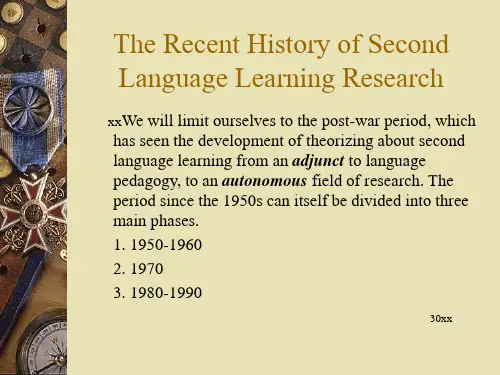
exposed to numerous stimuli in their environment. The response they give to
such stimuli will be reinforced if successful, that is if some desired outcome
practice makes perfect; in other words, learning would
take place by imitating and repeating the same
structures time after time. Second, teachers needed to
30+
The Recent History of Second Language Learning Research
Chomskyan Revolution
以转换 – 生成语法著称的乔式语言结构理论。1957年 因他的《句法结构》的发表而使语言学研究革命化。 到 60年代中期,Chomsky开始强调语言对研究人类心 灵所起的关键作用。他认为语言学应视为认知心理学 的一个分支,这一观点主要在《语言与心理》中作了 论证。正是他思想的这一方面广泛吸引了语言学以外 的学者,特别是在哲学界和心理学界。
35
The Recent History of Second Language Learning Research
Behaviorism in Linguistics
In the behaviorist view, language leaning is seen like any other kind of
In the 1950s and early 1960s, theorizing about language learning was still very much an adjunct to the practical business of language teaching. However, the idea that language teaching methods had to be justified in terms of and underlying learning theory was well established. At that time the general learning theory dominant in mainstream psychology was behaviorism.
二语习得研究文献综述
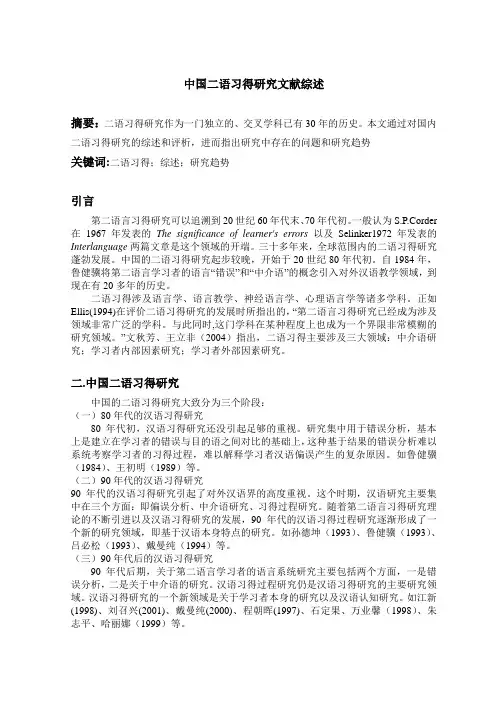
中国二语习得研究文献综述摘要:二语习得研究作为一门独立的、交叉学科已有30年的历史。
本文通过对国内二语习得研究的综述和评析,进而指出研究中存在的问题和研究趋势关键词:二语习得;综述;研究趋势引言第二语言习得研究可以追溯到20世纪60年代末、70年代初。
一般认为S.P.Corder 在1967年发表的The significance of learner's errors以及Selinker1972年发表的Interlanguage两篇文章是这个领域的开端。
三十多年来,全球范围内的二语习得研究蓬勃发展。
中国的二语习得研究起步较晚,开始于20世纪80年代初。
自1984年,鲁健骥将第二语言学习者的语言“错误”和“中介语”的概念引入对外汉语教学领域,到现在有20多年的历史。
二语习得涉及语言学、语言教学、神经语言学、心理语言学等诸多学科。
正如Ellis(1994)在评价二语习得研究的发展时所指出的,“第二语言习得研究已经成为涉及领域非常广泛的学科。
与此同时,这门学科在某种程度上也成为一个界限非常模糊的研究领域。
”文秋芳、王立非(2004)指出,二语习得主要涉及三大领域:中介语研究;学习者内部因素研究;学习者外部因素研究。
二.中国二语习得研究中国的二语习得研究大致分为三个阶段:(一)80年代的汉语习得研究80年代初,汉语习得研究还没引起足够的重视。
研究集中用于错误分析,基本上是建立在学习者的错误与目的语之间对比的基础上,这种基于结果的错误分析难以系统考察学习者的习得过程,难以解释学习者汉语偏误产生的复杂原因。
如鲁健骥(1984)、王初明(1989)等。
(二)90年代的汉语习得研究90年代的汉语习得研究引起了对外汉语界的高度重视。
这个时期,汉语研究主要集中在三个方面:即偏误分析、中介语研究、习得过程研究。
随着第二语言习得研究理论的不断引进以及汉语习得研究的发展,90年代的汉语习得过程研究逐渐形成了一个新的研究领域,即基于汉语本身特点的研究。
(完整版)二语习得文献综述
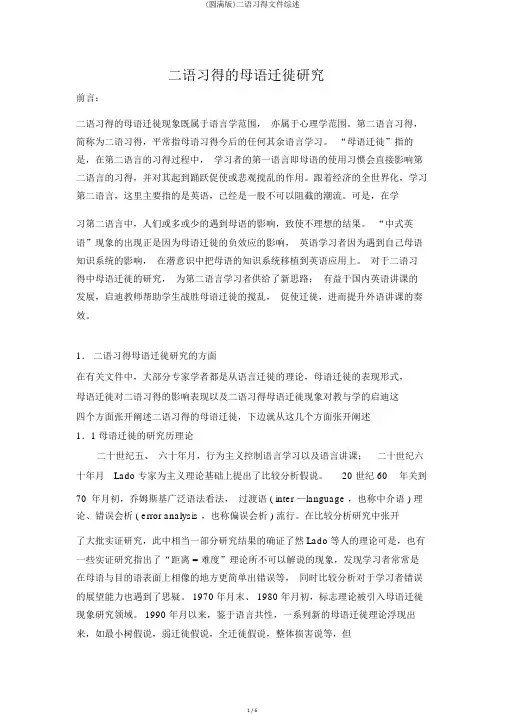
二语习得的母语迁徙研究前言:二语习得的母语迁徙现象既属于语言学范围,亦属于心理学范围。
第二语言习得,简称为二语习得,平常指母语习得今后的任何其余语言学习。
“母语迁徙”指的是,在第二语言的习得过程中,学习者的第一语言即母语的使用习惯会直接影响第二语言的习得,并对其起到踊跃促使或悲观搅乱的作用。
跟着经济的全世界化,学习第二语言,这里主要指的是英语,已经是一股不可以阻截的潮流。
可是,在学习第二语言中,人们或多或少的遇到母语的影响,致使不理想的结果。
“中式英语”现象的出现正是因为母语迁徙的负效应的影响,英语学习者因为遇到自己母语知识系统的影响,在潜意识中把母语的知识系统移植到英语应用上。
对于二语习得中母语迁徙的研究,为第二语言学习者供给了新思路;有益于国内英语讲课的发展,启迪教师帮助学生战胜母语迁徙的搅乱,促使迁徙,进而提升外语讲课的奏效。
1.二语习得母语迁徙研究的方面在有关文件中,大部分专家学者都是从语言迁徙的理论,母语迁徙的表现形式,母语迁徙对二语习得的影响表现以及二语习得母语迁徙现象对教与学的启迪这四个方面张开阐述二语习得的母语迁徙,下边就从这几个方面张开阐述1.1 母语迁徙的研究历理论二十世纪五、六十年月,行为主义控制语言学习以及语言讲课;二十世纪六十年月Lado 专家为主义理论基础上提出了比较分析假说。
20 世纪 60年关到70年月初,乔姆斯基广泛语法看法,过渡语 ( inter —language ,也称中介语 ) 理论、错误会析 ( error analysis ,也称偏误会析 ) 流行。
在比较分析研究中张开了大批实证研究,此中相当一部分研究结果的确证了然 Lado 等人的理论可是,也有一些实证研究指出了“距离 = 难度”理论所不可以解说的现象,发现学习者常常是在母语与目的语表面上相像的地方更简单出错误等,同时比较分析对于学习者错误的展望能力也遇到了思疑。
1970 年月末、 1980 年月初,标志理论被引入母语迁徙现象研究领域。
二语词汇习得文献综述
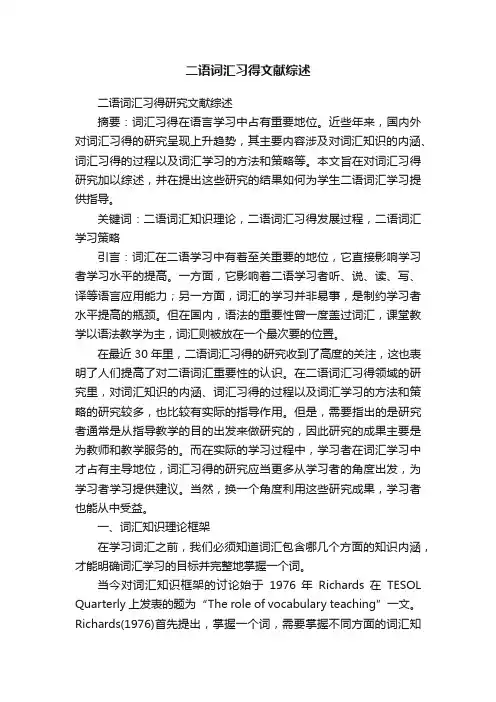
二语词汇习得文献综述二语词汇习得研究文献综述摘要:词汇习得在语言学习中占有重要地位。
近些年来,国内外对词汇习得的研究呈现上升趋势,其主要内容涉及对词汇知识的内涵、词汇习得的过程以及词汇学习的方法和策略等。
本文旨在对词汇习得研究加以综述,并在提出这些研究的结果如何为学生二语词汇学习提供指导。
关键词:二语词汇知识理论,二语词汇习得发展过程,二语词汇学习策略引言:词汇在二语学习中有着至关重要的地位,它直接影响学习者学习水平的提高。
一方面,它影响着二语学习者听、说、读、写、译等语言应用能力;另一方面,词汇的学习并非易事,是制约学习者水平提高的瓶颈。
但在国内,语法的重要性曾一度盖过词汇,课堂教学以语法教学为主,词汇则被放在一个最次要的位置。
在最近30年里,二语词汇习得的研究收到了高度的关注,这也表明了人们提高了对二语词汇重要性的认识。
在二语词汇习得领域的研究里,对词汇知识的内涵、词汇习得的过程以及词汇学习的方法和策略的研究较多,也比较有实际的指导作用。
但是,需要指出的是研究者通常是从指导教学的目的出发来做研究的,因此研究的成果主要是为教师和教学服务的。
而在实际的学习过程中,学习者在词汇学习中才占有主导地位,词汇习得的研究应当更多从学习者的角度出发,为学习者学习提供建议。
当然,换一个角度利用这些研究成果,学习者也能从中受益。
一、词汇知识理论框架在学习词汇之前,我们必须知道词汇包含哪几个方面的知识内涵,才能明确词汇学习的目标并完整地掌握一个词。
当今对词汇知识框架的讨论始于1976 年Richards 在TESOL Quarterly 上发表的题为“The role of vocabulary teaching”一文。
Richards(1976)首先提出,掌握一个词,需要掌握不同方面的词汇知识。
到目前为止,被研究者普遍接受、被认为是最完美的词汇知识框架是由Nation(1990)提出的。
他认为,如果外语学习者在词汇使用方面要达到本族语者的程度,就应该掌握如下8个方面的词汇知识,即: (1) 词的口语形式;(2) 词的书写形式;(3) 词的语法行为;(4) 词的搭配形式;(5) 词的使用频率;(6) 该词所应用的文体;(7) 词的意义;(8) 词的语义联想网络。
回顾综述二语习得研究方法

结合定量和定性分析结果,全面评估不同学习者的二语习得情况,为 教学和研究提供启示和建议。
07
研究方法的优缺点及适用性
实验研究方法的优缺点
优点
能够控制变量,明确因果关系; 实验结果可重复验证,具有较高 内部效度。
缺点
实验环境可能与真实环境存在差 异,影响外部效度;对实验者和 参与者要求较高,实施难度较大 。
缺点
难以将结论推广至更广泛群体;可能存在主观偏见或信息不 全等问题。
对比研究方法的优缺点
优点
通过比较不同组别或情境,揭示差异和共性;有助于深入理解现象或问题的本质 。
缺点
对比组和实验组的选择可能存在偏差或不匹配;对比过程中可能忽略其他潜在影 响因素。
08
结论与展望
研究结论总结
二语习得受多种因素影响
背景
二语习得研究作为语言学和应用语言 学的重要分支,一直受到广泛关注。 随着全球化的加速和多元文化的交融 ,二语习得研究的重要性愈发凸显。
二语习得研究的重要性
01
02
03
语言交流
二语习得研究有助于提高 语言学习者的交流能力, 促进跨文化交流。
教育改革
二语习得研究为教育改革 提供理论支持和实践指导 ,推动语言教育的创新和 发展。
多样性
03
考虑不同背景、不同阶段的二语学习者,以增加案例的多样性
和广度。
案例分析过程
数据收集
通过访谈、观察、问卷调查等方式收集案例 相关数据。
案例描述
详细描述案例的背景、人物、事件等,呈现 案例的全貌。
数据分析
对收集到的数据进行整理、分类和编码,以 便进行深入分析。
案例解释
分析案例中的关键问题和现象,解释其产生 的原因和影响。
二语习得 文献综述 作业样本
英师11101班201100495姓名:关于年龄因素与二语习得研究的文献综述姓名:摘要:年龄问题是二语习得研究领域一个热点话题,其研究主要集中在探讨语言学习有无一个敏感期(sensitive period)或临界期(critical period,有人译做关键期)的问题上。
通过对近20年来一些具有代表性的论文的分析,大概可将这些研究分为两类,一是翻译和评介外国理论,二是探讨年龄差异与外语教学。
关键词:年龄因素,二语习得,文献,综述。
第二语言习得(Second Language Acquisition)是一个相对比较年轻的一个领域。
但是,在过去的四、五十年间该领域的各项研究已有了一个长足的发展与进步。
年龄问题是二语习得研究领域一个热点话题,其研究主要集中在探讨语言学习有无一个敏感期(sensitive period)或临界期(critical period,有人译做关键期)的问题上。
(王初明,2001)我国学者除了翻译介绍国外理论以外,还主要探讨了所谓临界期或关键期对于外语教学的启示等问题,这方面已有大量文章问世。
下面,笔者将对近20年来关于二语习得年龄问题的论文作一综述,疏漏不当之处,敬请指教。
一、翻译、评介国外理论的论著国外有关二语习得年龄研究的理论成果大多围绕着所谓的关键假说(Critical Period Hypothesis,或译临界期假说)展开的。
这一理论最初的构想来自Lennenberg(1967),后来围绕此理论形成支持派和反对派。
我国学者对国外理论的引进主要集中在对支持派和反对派观点的介绍和评述上。
戴曼纯介绍了C .Snow和M. Hoefnagel-hohle(1978)有关关键期假说的相关试验及研究,以及一些学者有关“敏感期”假设的实验研究(戴曼纯,1994)。
王初明就国外语言习得临界期的研究所取得的成果进行了大致介绍(王初明,2001)。
王立非和李瑛就美国二语习得专家David Birdsong在1999年出版的《第二语言习得与关键期假设》(Second Language Acquisition and the Critical Period Hypothesis)一书作了评介(王立非、李瑛,2002)。
二语习得综述
二语习得综述Second Language AcquisitionWhat is SLA?Second Language Acquisition (SLA) refers both to the study of individuals and groups who are learning a language subsequent to learning their first one as young children, and to the process of learning that language. The additional language is called a second language (L2), even though it may actually be the third, fourth, or tenth to be acquired. It is also commonly called a target language (TL), which refers to any language that is the aim or goal of learning. The scope of SLA includes informal L2 learning that takes place in naturalistic contexts, formal L2 learning that takes place in classrooms, and L2 learning that involves a mixture of these settings and circumstances.*Language learners can study the language as a school subject, consciously learning and memorizing facts about the language. This results in conscious knowledge about the language that is referred to as declarative knowledge陈述性知识or explicit knowledge 隐性知识. Stephen Krashen calls this language learning.*Language learners can also gradually gain unconscious control overthe language by using it actively for functional and communicative purposes. This results in unconscious knowledge that is referred to as procedural knowledge过程性知识or implicit knowledge显性知识. Stephen Krashen calls this language acquisition.----二语习得内隐外显学习研究-问题与思考-戴炜栋语言的本质Nature of Language语言现象有生理及心理的基础,同时也是历史及文化的产物。
二语习得过程理论国内外研究综述
二语习得过程理论国内外研究综述摘要:本文采用历时文献分析法,以上世纪80年代Krashen提出的“输入假说”为起点,从语言输入、吸收、输出三个角度,对有关二语习得过程的国内外研究进行梳理和述评,最后指出这些理论成果的发展对我国的外语教学所具有的启发意义。
关键词:二语习得;输入;吸收;输出引言第二语言习得过程是指“在自然和指导的情况下通过有意识学习或无意识吸收掌握母语以外的一门语言的过程”(Ellis,1985)。
在二语习得的过程中,输入、吸收与输出是三个最为关键的环节。
“输入”是指在语言学习中,学习者能接收到的并能作为学习对象的语言,输入的形式包括听和读;“吸收”是指被内化并纳入中介语系统的输入部分,从根本上讲,只有被吸收的输入才会对二语习得起作用;“输出”是指学习者在经过输入吸收后产出的语言与信息,输出的形式包括说和写。
随着认知心理学、应用语言学和信息加工理论的发展与渗透,越来越多的研究者开始剖析输入、吸收与输出。
本文将以Krashen“输入假说”为基点,从输入、吸收与输出的角度,对二语习得过程理论的发展过程进行述评,最后阐述其对我国的外语教学具有的启示意义。
一、二语习得过程的研究视角1.输入理论及其发展述评上世纪80年代初,美国南加州大学教授Krashen在他的“监控模式”(the Monitor Model)中首次使用了“可理解输入”(comprehensible input)这一概念,并将可理解输入假说,即“i+1理论”,作为其“监控模式”的核心内容。
根据Krashen (1982)的定义,如果学习者现有的语言水平是i,可理解的语言输入应该是i+1。
i与i+1的缺口或距离,是通过交际过程中的语言结构的调整,以及语言环境所提供的信息和学习者以往的经验来弥补的。
Krashen(1985)进一步指出,最佳的语言输入应具备四个特征:可理解的,有趣且关联的,非语法程序安排的和足够量的。
2.吸收理论及其发展述评Corder(1967)首先将语言输入(input)与吸收(intake)区分开来,他认为输入是学习者可及的,课堂上呈现给学生的语言输入形式不一定能保证语言的吸收,即使是可理解输入也是如此。
二语习得中学习动机的文献综述
二语习得中学习动机的文献综述第二语言习得中学习动机的文献综述做为一项研究的重要组成部分,学习动机在第二语言习得领域中有着十分重要的地位,而研究关于学习动机的文献也衍生出多个分支。
本文对第二语言习得中学习动机的文献做出一个全面总结。
许多学者将学习动机分为有静态及动态两种类型,两者有着不同的本质特征。
静态动机一般是人们内在的精神力量,例如学习积极性,学习能力等。
而动态动机与其所处的环境,以及影响学习成果的因素有着密切的联系,例如文化社会环境,社会网络与学习资源等因素。
根据以上分类,文献中对第二语言习得中学习动机的研究可以分为静态动机的研究、动态动机的研究以及前者和后者的结合。
关于学习动机的研究,涉及到静态动机的最传统的研究便是对学习者的个人特质的探究,例如学习能力、学习积极性等。
像上述因素受到母语环境的影响较小,较为固定,一致性具有较高的规律性。
而相比之下,动态动机更关乎学习者所处的文化社会环境,其特征与环境变化息息相关,加之多变性较高,其研究考虑的因素要比静态动机数量过多多。
文献研究的手段也从观察和洞察到心理测量等多样化。
另一方面,学习动机的研究也受到影响,与学习者的文化资源有相应的联系。
比如,教师对学习者文化信仰的认知会对学习动机产生显著影响。
同时,学习者社会网络中的资源和学习资源也会影响学习动机。
这些因素对学习者习得第二语言能力有重大影响,因此也是需要关注的焦点。
综上所述,第二语言习得中学习动机的文献研究大致可以概括为静态动机的研究、动态动机的研究以及其交互研究。
在此,需要着眼于学习者所处的文化社会环境和相关资源,分析和诠释其影响习得学习动机的因素,以期获得更深入的认知。
- 1、下载文档前请自行甄别文档内容的完整性,平台不提供额外的编辑、内容补充、找答案等附加服务。
- 2、"仅部分预览"的文档,不可在线预览部分如存在完整性等问题,可反馈申请退款(可完整预览的文档不适用该条件!)。
- 3、如文档侵犯您的权益,请联系客服反馈,我们会尽快为您处理(人工客服工作时间:9:00-18:30)。
二语习得的母语迁移研究引言:二语习得的母语迁移现象既属于语言学范畴,亦属于心理学范畴。
第二语言习得,简称为二语习得,通常指母语习得之后的任何其他语言学习。
“母语迁移”指的是,在第二语言的习得过程中,学习者的第一语言即母语的使用习惯会直接影响第二语言的习得,并对其起到积极促进或消极干扰的作用。
随着经济的全球化,学习第二语言,这里主要指的是英语,已经是一股不可阻挡的潮流。
然而,在学习第二语言中,人们或多或少的受到母语的影响,导致不理想的结果。
“中式英语”现象的出现正是由于母语迁移的负效应的影响,英语学习者由于受到本身母语知识体系的影响,在潜意识中把母语的知识体系移植到英语应用上。
对于二语习得中母语迁移的研究,为第二语言学习者提供了新思路;有利于国内英语教学的发展,启发教师帮助学生克服母语迁移的干扰,促进迁移,从而提高外语教学的成效。
1.二语习得母语迁移研究的方面在相关文献中,大部分专家学者都是从语言迁移的理论,母语迁移的表现形式,母语迁移对二语习得的影响表现以及二语习得母语迁移现象对教与学的启示这四个方面展开论述二语习得的母语迁移,下面就从这几个方面展开论述1.1母语迁移的研究历理论二十世纪五、六十年代,行为主义控制语言学习以及语言教学;二十世纪六十年代Lado在行为主义理论基础上提出了对比分析假说。
20 世纪 60 年末到70 年代初,乔姆斯基普遍语法观点,过渡语( inter—language,也称中介语) 理论、错误分析( error analysis,也称偏误分析) 兴起。
在对比分析研究中展开了大量实证研究,其中相当一部分研究结果确实证实了 Lado 等人的理论但是,也有一些实证研究指出了“距离 = 难度”理论所不能解释的现象,发现学习者往往是在母语与目的语表面上相似的地方更容易犯错误等,同时对比分析对于学习者错误的预测能力也受到了质疑。
1970 年代末、1980 年代初,标记理论被引入母语迁移现象研究领域。
1990 年代以来,基于语言共性,一系列新的母语迁移理论涌现出来,如最小树假说,弱迁移假说,全迁移假说,整体损伤说等,但总的说来,研究者都不再将普遍语法和母语迁移视作对立,而是在接受普遍语法在二语习得过程中起到某种制约作用的前提下,希望在普遍语法框架内解释母语迁移在中介语初始状态中的作用。
他们深入研究母语向目的语迁移的内容、比重和方式等,其中一部分侧重于母语迁移在语音词汇习得,句法和写作等方面的影响。
近年来,不少学者开始使用语料库作为研究工具对母语迁移进行研究。
有些学者认为与对比分析假设相比较,语言标记性理论对于解释母语迁移现象及第二语言习得者面临的学习困难有较明显优势。
有些学中认为对比分析理论仍然是研究二语习得的语言迁移的主要理论,提出不应该因为理论所存在的某些缺陷而否认。
但是不可否认的是,对比分析假设、语言标记性理论和普遍语法理论在二语习得的语言迁移研究中占主流。
总的来说,人们对母语作用的认识逐渐接近本质,不再把母语迁移当作二语学习困难和中介语错误的唯一根源,或者根本否认母语影响的存在,而是视迁移过程为受语言结构的标记性、学习者的心理类型和中介语发展的自身规律等因素制约的二语习得过程之一。
1.2母语迁移的主要表现形式母语迁移的表现形式多样,最主要的表现形式分别有五种,正迁移,负迁移,回避,过度使用和语言习得时间的不同。
然而,学者们的研究大多只专注于正迁移和负迁移,忽略了其他几种方式的研究。
不可否认,不同语言中存在着相同的地方,也就是语言间的共性,但是它们又因为自身的特殊性而与其他语言不相同,而语言间的共性和每种语言的特殊性造成了二语习得的正迁移和负迁移。
习者因为母语和目的语的差异而试图避免使用某些语言结构或者是过度使用一些简单结构,这就是母语迁移的回避和过度使用两种表现形似。
然而,很多研究都是专注于母语迁移的正迁移而负迁移,而在回避,过度使用和语言习得时间不同方面的研究比较少。
关于语言习得时间的不同,研究领域中更存在着矛盾。
语言学家普遍认为儿童习得各自母语的时间大致相同,但母语与第二语言习得存在很大差异,成人习得第二语言所需的时间相差很大。
然而,有学者认为小孩能够短时间内轻易地掌握语言,从某种程度上说,这是片面的。
凯丽比努认为小孩在掌握语言的过程所付出的努力与时间并不少于成人,而是被研究者忽略了而已,在1-3岁每天都不断地接受语言知识的情况下,小孩三岁才能呀呀呓语,说出不完整的话语,而成人用三年的时间学习第二语的话,即成人学习者用三年的时间,常住在目的语家庭里,并且由目的语家庭的成员天天跟他交流,(就像对待小孩样)我们敢保证他的听说能力绝对比3岁的孩子强。
1.3母语迁移影响表现关于母语迁移对二语习得的影响,综合所有文献,影响主要表现在语音,词汇,语法,文化,思维方式这四个方面。
大部分的研究都主要集中在语音、语法与文化上,对于思维方式的研究较少。
在语音方面,大多数学者都认为中英之间的音素结构和音节体系,韵律特征的差异影响二语习得,但也有学者指出发声的部位以及语流的变音的差异会影响二语习得。
在语法方面,学者们普遍都从综合语和分析语,形合和意合的差异着手,比较少从物称和人称,动态和静态的差异着手。
词汇对二语习得的影响,普遍地,学者们都把它归纳到文化差异不同而造成的。
英汉两族人民虽生活于同一星球,但由于他们所处的地位置不同,两种语言的形成有着各自不同的社会、历史、经济、文化等原因,从而也导致两种语言词汇含义的差异。
除有些科技术语和少量的基本词汇在两种语言中含义相当外,其它词汇的含义在两种语言中均或多或少存在差异,即使是最基本的概念意义,也未必完全一致。
母语文化对二语习得的影响,主要体现在交际场合上,主要表现在问候、致谢、称赞、约会、禁忌等方面。
“禁忌”(taboo),“隐私”(privacy)的概念对于中学生来说非常难掌握。
中国学生也许一点也没意识到:随便问外籍教师的年龄、收入,体重或者一件东西的价钱,都是对他的“隐私”的侵犯。
中国人眼中有些习以为常的事情,在西方人眼中是“隐私”,应当回避,否则就是失礼,不能为英美人所接受。
在思维方式方面,在学英语的过程中,中国学生往往通过母语的中介作用(心译活动)来进行思维。
他们在用英语时习惯要先在脑子里进行一道翻译程序,这样在听说英语时,往往跟不上正常语速:在读和写的时候,英语的使用也会受到干扰。
例如:在写英文句子时,由于学生思维过程多以汉语进行,结果他们用的是英语词汇,依照的是英语语法规则,写出来的却是汉语式的英语句子。
在思维方式的研究,是具有深刻意义的,也是立足于中介理论,转变思维方式无疑会提高第二语言学习的效率。
1.4母语迁移对二语教与学的启示因为语言的可迁移性,在教与学上,学者们都一致认为我们可以利用语言的可迁移性,促进教与学。
大部分学者是从克服负迁移,利用正迁移的角度展开。
克服负迁移:利用对比分析进行教学,归纳总结两种语言间的异同点;强化用英语模式进行思考;面对并宽容因为母语迁移而在第二语言学习上产生的错误;创造第二语言学习的氛围;导入文化教学利用正迁移:发挥母语的桥梁作用;运用母语知识来通过目标语进行交流。
同时有学者(凯利比努)认为,学习第二语言应该好好利用在我们大脑里的母语语言模式架,这对第二语言习得过程中起决定性作用,它能帮助学习者建立新的目的语语言模式架。
从上可知,目前对母语迁移对二语教与学的研究主要建立在语言迁移的负效应能的基础上,并且缺少试验证明。
2.二语习得的母语迁移研究小结关于二语习得的母语迁移研究的相关理论,成果,可由下表总结3.二语习得的母语迁移研究结论二语习得的母语迁移研究理论从未停止,并且活跃于当今教育研究领域。
寻找理论支撑点,划分语言迁移的类型,分析出母语对二语习得的影响,并进一步指出语言迁移对二语习得教与学的启示,这四个部分已经成为了研究的必要展开部分。
在此研究领域上,关于语言习得的时间这部分存在这较大的差异,在二语习得回避、过度使用以及在语言习得时间上的研究较少,并且主要停留在理论层面,缺少实证。
但是,随着半世纪以来国内外的研究,并且基于语料库的研究,二语习得的母语迁移的研究在外语的教与学上确实产生了深刻的影响,人们在教学方式与学习方式也相应地做出了调整。
4、参考文献:[1] 许菊.母语迁移的认知理据[J].中南民族大学学报,2005,25(1):159-162.[2] 刘畅,程邦雄. 母语迁移研究:回望与思考[J].江汉大学学报,2012,11(6):96-101.[3] 赵书博,满屹. 二语习得中的母语迁移[J].现代交际,2011(2):26-27.[4] 鄂恒博. 母语迁移对英语学习的影响及教学策略[J].北方文学,2012(2):168-169.[5] 周丽芳. 克服干扰促进迁移——母语迁移现象对英语教学的启示[J].江西教育学院学报,1999,20(5):21-24.[6] 刘玉萍. 二语习得中的母语迁移及其对英语教学的启示[J].辽宁行政学院学报,2009,11(3):150-151.[7] 白凤欣. 论第二语言习得中的母语迁移及其对英语学习的影响[J]. 沧州师范专科学校学报,2007,23(2):70-71.[8] 凯丽比努. 第二语言习得中的母语迁移[J].兰州学刊,2009(8):165-168.[9] 刁纪田. 浅析母语迁移在英语学习中的正负效用[J]. 山西大学学报,2001,24(1):73-76.[10] 寮菲. 第二语言习得中母语迁移现象分析[J].重庆大学学报,1997(4):82-88[11]苏留华,母语迁移对第二语言学习的影响[J]. 北京第二外国语学院学报,2000(4):44-52。
